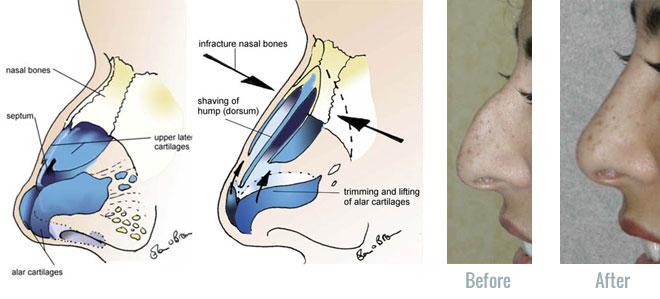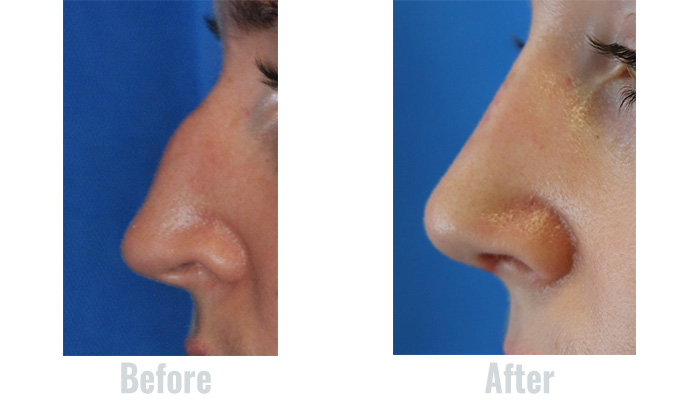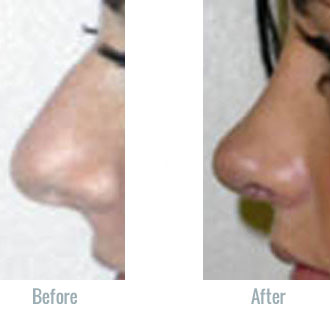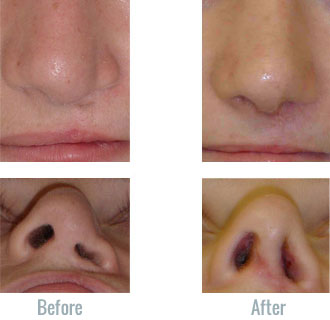Rhinoplasty (Nose Job) Scenarios
Hook nose/ Roman nose/ Dorsal hump
Reduction of a hook nose or roman nose is the most common type of rhinoplasty performed. If this is your main problem, it can be addressed with a relatively straight forward hump reduction. This can be done as a closed preservation rhinoplasty, if minor or an open rhinoplasty otherwise. Adjustments are made to the tip cartilages to allow them to sit in the correct position. (alar trim)


Twisted nose/ Nasal deviation
This is a more complicated problem and usually requires an open septoplasty. Mild cases may be treated with a strategically placed dorsal graft to hide the asymmetry. Most cases will require removal of the deep portion of the septum (submucous resection) , which is then used to reinforce and help straighten the front (visible) part of the septum. Sometimes the septum is so buckled that it is better to remove it altogether and completely remodel it . (extra-corporeal) . The straightened septum is then reinserted. Tip adjustments and infractures may also be required.


Big nose, out of proportion to the rest of the face.
Correction of this problem , requires reduction of all elements of the nose with dorsal reduction, infractures, and tip reduction (alar cartilage reduction and remodelling). Often people with this problem have thick skin which may limit the effectiveness of the size reduction. Sometimes the nose is out of proportion because the chin is small. Some cases may benefit from chin enlargement (bony augmentation or chin implant).

Broken/collapsed or saddle nose
Trauma to the nose usually causes deviation or twisting of the nose but in severe cases the septum may completely collapse. This gives the appearance of a flat (boxers nose), with very little nasal bridge.
Some people are born with an underdeveloped septum. This can also occur after certain infections or with cocaine abuse. This is a difficult problem to fix, usually requiring cartilage graft from the ear or a rib. The graft is used to build up the missing septum.

Tip deformities
There are many variations in the shape and size of the nose tip. Examples of tip shape variations that cause issues for patients are; the pointy tip, broad flat tip, drooping tip, boxy tip and the asymmetrical tip
The tip is made up of two alar cartilages which look like bird’s wings. The alar cartilages are supported in the midline by the septum . Altering the shape of the tip requires careful and expert sculpting of these elements . These operations are best done as an open rhinoplasty.

The Cleft Nose Deformity
One of the most difficult challenges in rhinoplasty surgery is the correction of the cleft nose deformity. This is a complex asymmetrical deformity that occurs in adults who had a cleft lip as a child. These operations often involve placement of multiple cartilage and other grafts in attempt to restore the symmetry; however, due to the presence of scarring and the extent of the deformity, it is not always possible to fully correct the asymmetry and the appearance. However, it is possible to make great improvements which can be very rewarding.

Deformity from Previous Surgery
There are many minor and more significant deformities that can occur as a result of previous surgery and is not unusual to have small contour irregularities particularly in and around the bony work were infractures have occurred. Sometimes a small step or little lumps can be felt and these can be quite frustrating for the patient.
More significant problems from surgery may require more advanced reconstructive techniques and frequently these procedures would include the use of graft material, either cartilage from the ear or rib or even small sections of dermis (skin and fat in order to restore a smooth contour).
Other Complex nose deformities
There are other, less common scenarios which have not been addressed in this brief summary. Some of these problems can be very complex , and include nose deformities, after cancer surgery or major trauma. These problems require the use of many techniques and may even involve multiple procedures.
